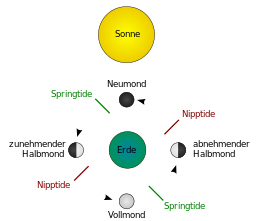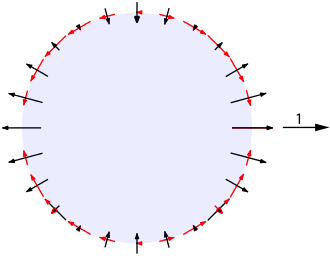Tide
![]()
This article deals with tides specifically on Earth. The causes of tides on all celestial bodies are in the article Tidal Forces.
![]()
Tide is a redirect to this article. For other meanings, see Tide (disambiguation).
The tides (Low German Tid, Tied [tiːt] "time"; pl. Tiden, Tieden [tiːdən] "times") are the movements of water in the oceans caused by the associated tidal forces as a result of the gravitational pull of the moon and the sun. The tides predominantly affect the coasts. Since the stronger influence comes from the moon, there are not two high tides and two low tides in 24 hours, but in just under 25 hours, because the moon is only in approximately the same position in the sky again after an average of 24 hours 49 minutes.
The tidal forces act in the sense of a symmetrical stretching of the earth along the line to the moon or the sun. Since no stable deformation can occur due to the Earth's rotation, the tidal forces periodically stimulate currents in the oceans, especially in the middle latitudes. These cause the water level to rise and fall periodically. At full and new moon, the sun and moon are on the same line from the earth, which is why their effects add up to a particularly large tide, the spring tide. At half moon, on the other hand, the sun and moon are at right angles to each other, resulting in a particularly small tide, the neap tide. The tidal forces of the sun are about 46% of those of the moon.
Particularly large tidal forces and spring tides occur about every 15 months, when the moon is again very close to the earth due to the slow rotation of the elliptical lunar orbit. In addition, the variable inclination of the moon's orbit to the earth's axis results in an approximately annual variation of the tides.
The science of the earth's maritime tides is called tidology. Its basic statements are part of nautical training.

High and low tide at a jetty in the Bay of Fundy

Schematic representation of the occurrence of Spring and Nipple Tides; inertias cause Spring Tides, for example, to occur somewhat later than at full and at new moon.
.jpg)
Sandbanks in the tidal area of the Lower Saxony Wadden Sea National Park (2019)
Explanation of the tides
Tides are caused by the interaction of the Earth's daily rotation in the (almost fixed) gravitational field of the Moon and the Sun, and the fact that this gravitational field is not equally strong everywhere, but pulls the Earth slightly along. The forces that cause this are called tidal forces. A location on the Earth's surface reaches a point of maximum tidal force and a point of minimum tidal force twice in each revolution. Although the tidal force accounts for less than one ten-millionth of the Earth's gravitational pull, it is a periodic disturbance of an otherwise stable state of equilibrium. The oceans respond to this disturbance with back-and-forth oscillating currents, which become noticeable on coasts by periodic raising and lowering of sea level. In many places, differences in height of well over 1 metre are reached.
Explanation of tidal forces
A gravitational field invokes an acceleration 





One relates the gravitational acceleration of the center of mass at location 
The tidal acceleration shows itself directly in the acceleration of the motion of the (otherwise force-free) mass point relative to the center of mass of the cloud. In the reference frame in which the center of mass is at rest, each mass point behaves as if the tidal force
acts. Alternatively to this derivation, one can explicitly perform a transformation of the reference frame from an inertial frame to the rest frame of the center of mass of the cloud. This reference frame is 


The same tidal force also works, if the mass points, of which the celestial body under consideration consists, feel further forces, e.g. mutual gravitation, cohesion etc., but also a further external force field. However, in the accelerated movement of a mass point, the tidal force does not appear directly, but only in the sum with the other forces acting on the mass point. It then can cause e.g. deformations and/or flows, depending on how fix mass-points are bound to their location.
This derivation of tide-acceleration and tide-force is valid independent of track or motion-state of celestial body (e.g. linear or circled, with or without rotation). The assumptions made in many textbooks, for example, about its circular motions and the associated centrifugal forces (which, by the way, are only exact for uniform circular motion) serve there merely to determine the acceleration of the center of mass in order 
The tidal force caused by a celestial body is strongest at the two opposite points of the earth's surface, which have the smallest and largest distance to the celestial body. There it points vertically outwards, i.e. at the smallest distance directly towards the celestial body, at the greatest distance directly away from it. At points on the earth's surface which are the same distance from the celestial body as the earth's centre of mass, the tidal force is smallest and points vertically inwards. At an intermediate range, the tidal force is directed parallel to the Earth's surface and can therefore efficiently drive currents in the ocean.
Why does the sun's gravitational field pull the earth a bit?
For a simple explanation, instead of the solid earth, consider a fictitious spherical cloud of small particles that orbit the sun together, but do not exert any forces on each other (not even gravity). All particles move (at first) with the same angular velocity ω 




Tidal acceleration (blue) due to the Moon for locations on the Earth's surface as the difference between the local gravitational acceleration (green) and the acceleration of the center of mass.
Calculation of tidal accelerations
Tidal accelerations are acceleration differences between different points of an external field. The external field is always a superposition of central fields, here mainly of sun and moon. The simplest case is that of a central field, i.e. of the sun or moon. The accelerations are determined using a test mass, which is placed once at the location of the center of mass of the Earth and once at the location of interest. The acceleration at the center of mass is equal to the acceleration of a rigid earth. The other location of the test mass can be anywhere in the earth, e.g. in the moving hydrosphere.
is the amount of acceleration in the gravitational field of the other celestial body (sun or moon) given by Newton's law of gravity. Where is 






With 




This is about one-thirtieth of the acceleration of the Earth towards the Moon. The acceleration due to gravity on Earth, 9.81 m/s2, is about 107 times greater.
Vertical and horizontal components of tidal acceleration
For the vertical and horizontal components of the tidal acceleration at any location on the Earth's surface that deviates from the Earth→Moon direction by angle θ as 


The graph on the right shows the decomposition of tidal acceleration into components perpendicular and parallel to the earth's surface.
Calculation example - acceleration of the earth and tidal acceleration on its surface by the sun
With the constants


results
for the gravitational acceleration of the earth originating from the sun, and
for tidal acceleration.
The tidal acceleration varies with the third power of the distance from the center of gravity and thus falls off faster than the gravitational acceleration, which varies quadratically. Although the Sun produces a gravitational acceleration at the location of the Earth that is almost 180 times greater than that of the Moon, the tidal acceleration it causes reaches only 46% of that caused by the Moon.
Superposition of the tidal forces caused by the moon and the sun
The tidal forces caused by the moon and the sun add up. The strongest total force occurs when the sun, earth, and moon are in alignment, which approximates at full and new moon with a period of about 14¾ days. Then they raise the water level of the ocean at high tide about ¾ meter (about ½ meter due to the moon and about ¼ meter due to the sun). At half moon, there is a right angle between the two force fields. Their superposition results in forces that raise the water level of the ocean less.

Decomposition of the locally different values of the tidal acceleration (or tidal force, see above graph) caused by the Moon into components. Arrow "1": Direction to the moon and axis of rotational symmetry.
Questions and Answers
Q: What is a tide?
A: A tide is the periodic rising and falling of Earth's ocean surface caused mainly by the gravitational pull of the Moon acting on the oceans.
Q: What changes do tides cause in the depth of marine and estuarine waters?
A: Tides cause changes in the depth of marine and estuarine (river mouth) waters.
Q: What are tidal streams?
A: Tidal streams are oscillating currents known as rip tides.
Q: Why is it important to predict the tide for coastal navigation?
A: Predicting the tide is important for coastal navigation because it can affect the depth of water and tidal streams.
Q: What is the intertidal zone?
A: The intertidal zone is the strip of seashore that is under water at high tide and exposed at low tide.
Q: Why is the intertidal zone an important ecological product of ocean tides?
A: The intertidal zone is an important ecological product of ocean tides because it provides habitat for many different species of plants and animals.
Q: How does the height of tides vary with the phases of the Moon?
A: The height of tides varies somewhat with the phases of the Moon. At New Moon and Full Moon, tides are higher because the Sun's tidal force adds to the Moon's. This is called "spring tide".
Search within the encyclopedia




